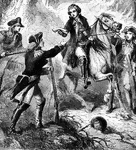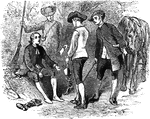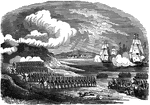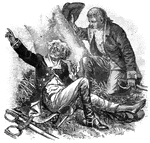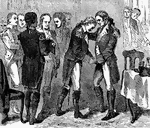Events in New York History
The Events in New York History ClipArt gallery offers 34 images of important New York state events from colonial times to the nineteenth century.

Battle of Bennington
A battle of the American Revolution, led by General John Stark. The defeat of the British army reduced…

Black Friday
"The New York Gold Room on 'Black Friday,' September 24, 1869."—E. Benjamin Andrews 1895

Bloody Pond
"Bloody Pond, near Lake George, which is said to still contain the bones of many of those who fell in…

Burning Stamps
"Burning the Stamps in New York, during the opposition of the Stamp Act in 1764."—E. Benjamin Andrews,…

Constitution Celebration
"Celebrating the adoption of the Constitution in New York."—E. Benjamin Andrews, 1895

The Draft Riots in New York - The Battle in Second Avenue
Rioting in New York City after passage of an unpopular draft.

The Half Moon in the Hudson
Henry Hudon's vessel the Halve Maen or Half Moon in the Hudson River when it was first discovered.
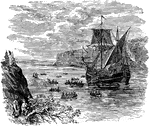
Hudson's Exploration
An illustration showing Henry Hudson's ship exploring the river which now bears his name.

La Colle Mill and Blockhouse
The Second Battle of Lacolle Mills was fought on March 30, 1814 during the War of 1812. The small garrison…

Landing of the Dutch settlers on Manhattan Island
The landing of the Dutch settlers on Manhattan, now the city of New York.
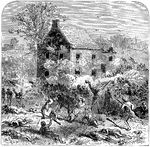
Lord Stirling's Last Stand Around the Cortelyou House
At the Battle of Long Island, in August of 1776, Stirling led the 1st Maryland Regiment in repeated…
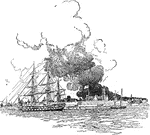
The Great Fire of New York in 1776
The Great Fire was a devastating fire that burned through the night of September 21 – September…
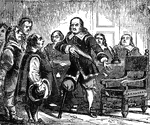
Peter Stuyvesant
Peter Stuyvesant, protesting vehemently against the signing of a treaty of surrender to the English

Battle of Plattsburg
The Battle of Plattsburgh, also known as the Battle of Lake Champlain, ended the final invasion of the…
!["Presentation of colors to the Twentieth United States [African American] Infantry, Colonel Bartram, at the Union League Clubhouse, New York, March 5th, 1864. The Twentieth Regiment, United States [African American] Troops, left Riker's Island at nine o'clock on the 5th of March, 1864, on board the steamer <em>John Romer</em>, and were conveyed to the foot of Twenty-first Street, East River, New York, where they were disembarked and formed in regimental line, and marched to Union Square, arriving in front of the Union League Clubhouse at one o'clock. A vast crowd of citizens, of every shade of color and every phase of social and political life, filled the square and streets, and every door, window, veranda, tree and housetop that commanded a view of the scene was peopled with spectators. Over the entrance of the clubhouse was a large platform, ornamented with flags and filled with ladies. In the street was another platform, tastefully decorated and occupied by prominent citizens. From the stand the colors were presented by President King of Columbia College, who addressed them with warmth and eloquence. After the presentation ceremony was over the men stacked arms and partook of a collation provided for them."— Frank Leslie, 1896](https://etc.usf.edu/clipart/11700/11749/presentcolor_11749_mth.gif)
Presentation of Colors
"Presentation of colors to the Twentieth United States [African American] Infantry, Colonel Bartram,…
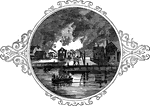
Destruction at Sodus Bay
During the War of 1812 Sodus Bay was mostly burned during an attack by the British.
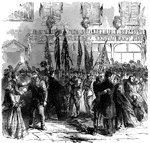
Soldiers Resting
"The soldier's rest--the friends of the Seventh and Eighth Regiments, New York Volunteers, welcoming…

State Prisoners at Fort Lafayette
"Landing state prisoners at Fort Lafayette, New York harbor, in 1861. Fort Lafayette, New York harbor,…

Stuyvesant decides to surrender
Peter Stuyvesant decides to surrender New Netherland to the English, 1664

Governor Peter Stuyvesant
Governor Stuyvesant tearing up the letter demanding the surrender of New Amsterdam.

Triumphal Arch in New York City
The arch erected in New York City to celebrate the return of Admiral George Dewey.
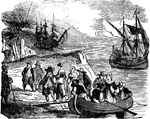
Landing of the Walloons
An illustration depicting the arrival of the Walloon settlers on Long Island.

Washington Resigning His Commission
At Fraunces Tavern on December 4, Washington formally bade his officers farewell and on December 23,…

Billy Wilson Zouaves
"The ('Billy') Wilson Zouaves, at Tammany Hall, taking the oath of fidelity to the flag, April 24th,…

Ellsworth's Zouaves
"The departure of Colonel Ellsworth's Zouaves from New york, escorted by the fire department- the regiment…
